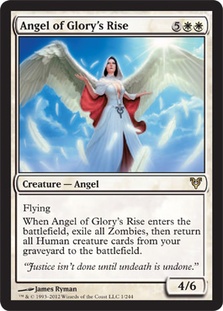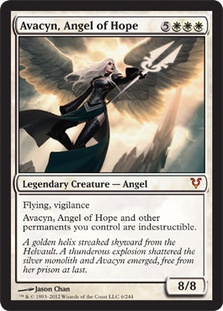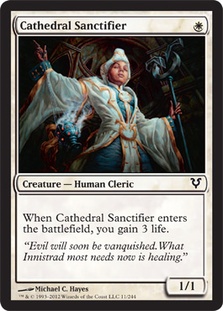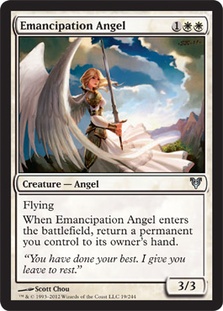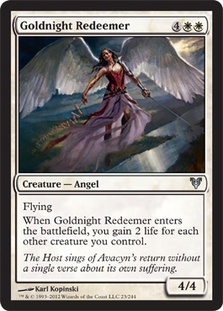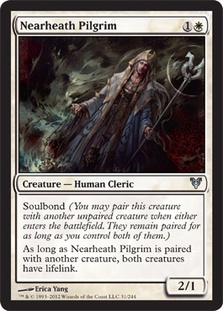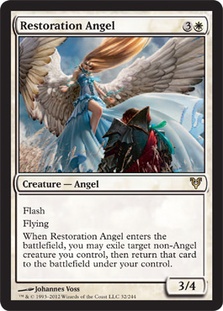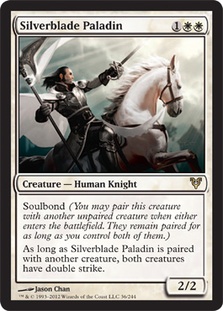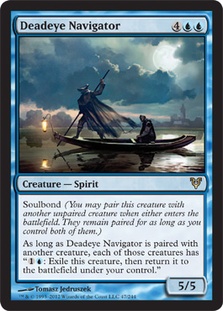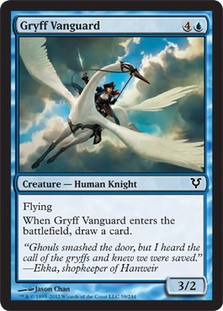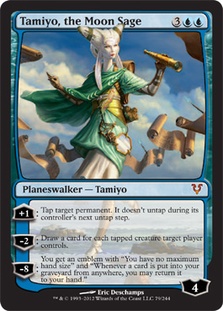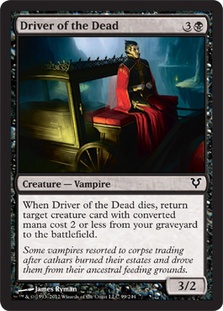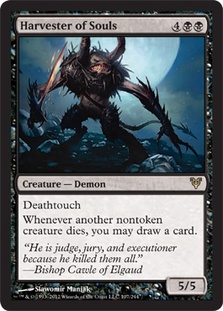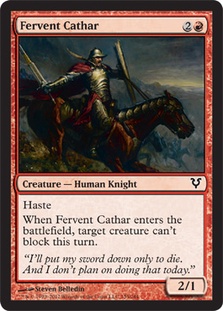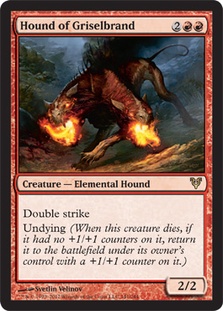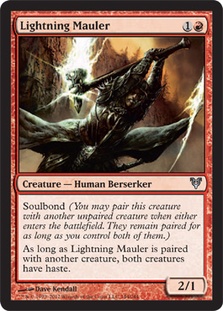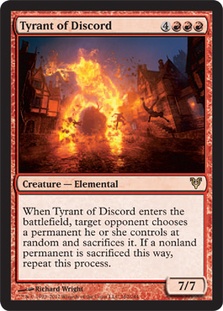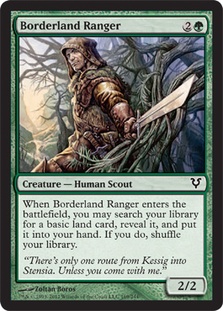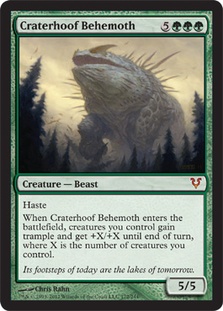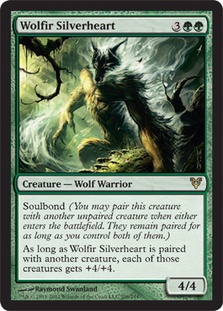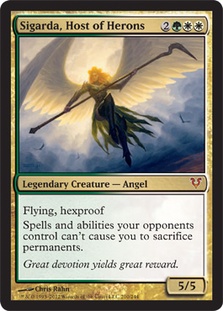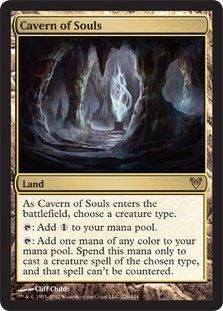Avacyn Restored has finally been fully spoiled! Some will be scouring over the spoiler to find the best new additions to their U/W Delver decklists, some will be testing all of the new cards to try to "break the format" and come up with a new metagame-breaking deck, but I’m here today to talk about how the new set will affect one of my favorite decks: Birthing Pod.
As a quick refresher, there are two prevailing Birthing Pod strategies. The first is an aggressive R/G/W (aka Naya) colored aggressive deck that uses Birthing Pod as a tool rather than an engine. The deck works by attacking with cards like Strangleroot Geist, Blade Splicer, and Huntmaster of the Fells, and often only plays two Birthing Pods. Here’s Austin Yost Top 16 decklist from SCG Birmingham this past weekend, closely resembling the list Brian Kibler has been advocating recently:
Creatures (30)
- 1 Llanowar Elves
- 4 Birds of Paradise
- 1 Acidic Slime
- 1 Inferno Titan
- 3 Phyrexian Metamorph
- 3 Blade Splicer
- 1 Fiend Hunter
- 3 Avacyn's Pilgrim
- 1 Daybreak Ranger
- 4 Strangleroot Geist
- 3 Thalia, Guardian of Thraben
- 4 Huntmaster of the Fells
- 1 Vorapede
Planeswalkers (2)
Lands (24)
Spells (4)

The other Birthing Pod strategy is to go "over the top" and win with Titans and Elesh Norn. Though the deck still plays Strangleroot Geist, Blade Splicer, and Huntmaster of the Fells, the deck plays much more defensively. This deck uses Birthing Pod as a very powerful engine ("I sacrifice my Birds of Paradise to get Phantasmal Image, copying Acidic Slime / Sun Titan / Wurmcoil Engine, etc."), but is less powerful in games when Birthing Pod is not in play. I recently wrote this article after making Top 8 at the SCG Standard Open in Baltimore with this list:
Creatures (25)
- 1 Solemn Simulacrum
- 4 Birds of Paradise
- 1 Acidic Slime
- 1 Primeval Titan
- 1 Sun Titan
- 1 Wurmcoil Engine
- 1 Viridian Emissary
- 1 Elesh Norn, Grand Cenobite
- 1 Phyrexian Metamorph
- 2 Blade Splicer
- 1 Deceiver Exarch
- 2 Phantasmal Image
- 1 Fiend Hunter
- 1 Geist-Honored Monk
- 1 Daybreak Ranger
- 3 Strangleroot Geist
- 2 Huntmaster of the Fells
Planeswalkers (2)
Lands (24)
Spells (9)

So what type of cards are we on the lookout for? The strategy benefits from all sorts of different cards, but I think the best question we can ask is, "Is it a card you are happy to play then immediately sacrifice?" Of course, we are sacrificing the creature for something presumably bigger and better, but generally we want powerful enters the battlefield or dying effects.
Any card that has powerful synergy with Birthing Pod in addition to being a powerful card on its own becomes an all-star in our deck, such as Strangleroot Geist. Some cards that are great in specific situations, such as Viridian Corruptor, often become great sideboard cards.
A Note On All These Soulbond Cards…
When I first looked at Silverblade Paladin (the first spoiled soulbond creature), I thought to myself, "Well, that’s a nice Limited mechanic." However, given the current state of Standard where decks are playing very few targeted removal spells, I could see soulbonded pairs doing a lot of work in Constructed.
Birthing Pod seems like a great strategy for soulbond because of the high creature count and the ability to pull up a soulbond creature in the right situation. It’s hard to correctly evaluate this mechanic with zero experience with it, but I am optimistic about soulbond’s power in this archetype. I’ll go into a few specific soulbond cards below, but now it’s time to evaluate some cards!
My Evaluations
Note: Feel free to disagree with me in the comments; I’m interested in people’s opinions on these cards!
Each card will be given two ratings: Likely/Possible/Unlikely/ based on how likely I expect the card is to see play and Staple/Role Player/Sideboard for its role in the deck. Staple refers to cards like Strangleroot Geist and Blade Splicer that are central to the archetype with multiple copies in the maindeck.
Role-Player refers to cards such as Acidic Slime or Elesh Norn; cards that play a role in the deck but rarely want more than one copy in the maindeck (sometimes a second in the sideboard). Sideboard refers to cards that shine in specific matchups, such as Viridian Corruptor. Finally, any cards that I don’t expect to see success in this archetype I will dub Doubtful.
White
Angel of Glory’s Rise — Its effect seems underwhelming and is incredibly narrow, but keep in mind that this Angel is better than Elesh Norn against Zombies and for the same cost. Also, there are a decent number of key Humans in most Pod decks, such as Blade Splicer or Huntmaster of the Fells. It’s worth noting, but I don’t expect it to see play. Unlikely Sideboard.
Angel of Jubilation — Sure, it shuts off your Birthing Pods and gives you one of the biggest anti-combos competitive Magic has seen, but this card is so good that it might be worth it. If it’s on the board and pumping all your creatures, do you really need more Birthing Pod activations? Unlikely Role Player.
Avacyn, Angel of Hope — Yeah, this card is definitely win-more for this deck. Your CMC seven creatures should be enough to win the game for you, so going the extra mile for a CMC eight creature doesn’t seem worth it. Doubtful.
Cathedral Sanctifier — Life gain? In the pre-rotation version of this deck, Lone Missionary was exactly what you wanted against B/R Vampires, and I can see Cathedral Sanctifier fulfilling a similar role against various aggro decks. The fact that you can Sun Titan this creature back or sacrifice it to either Birthing Pod or Garruk, the Veil-Cursed gives it more utility in this deck than other decks in the format. Possible Sideboard.
Emancipation Angel — While this card screams "value" in being able to rebuy a Blade Splicer or Huntmaster of the Fells, the 3/3 flying body is not horribly impressive and slow effects are not what you want in this deck. Garruk Relentless, Birthing Pod, and Gavony Township are already great ways to grind out an advantage from a stalled board state. You want creatures that can provide tempo, and this creature does the opposite. Doubtful.
Goldnight Redeemer — Well, it gains life more immediately than any other six-drop available, but Sun Titan or Wurmcoil Engine is probably just better in this slot. Unlikely Sideboard.
Nearheath Pilgrim — Soulbonded lifelink! Unfortunately, this card requires some setup, so I think Cathedral Sanctifier is probably going to be the winner for life gain effects against aggro. Doubtful.
Restoration Angel — This card is insane, but it should be treated more like an auxiliary Birthing Pod rather than a four-drop. It acts upon creatures you already control rather than producing advantage on its own. Imagine this sequence of plays: turn 1 Birds of Paradise, turn 2 Blade Splicer, turn 3 Birthing Pod sacrificing Blade Splicer to get…definitely not Restoration Angel. Instead, if you don’t have a Birthing Pod in your hand, using Restoration Angel to reset your Blade Splicer is a fine play. Likely Role Player, Possible Staple.
Silverblade Paladin — While sacrificing Strangleroot Geist to go get Silverblade Paladin and attacking with your newly double striking hasty 3/2 is pretty attractive, playing Silverblade Paladin on turn 2 off of a mana dork is pretty underwhelming. I think this card is a little too swingy and reliant on the other creatures available to be great. Unlikely Role Player.
Blue
Deadeye Navigator — Yeah, this guy is just way too durdly to make an impact when you need him to make an impact. Doubtful.
Gryff Vanguard — Its body is too small and one card is too little for this guy to be good. Doubtful.
Tamiyo, the Moon Sage — Tamiyo does a great job of playing her own game, but she doesn’t really do that much to further your own strategy of playing creatures and upgrading them until you crush your opponent. She may be worth playing to attack from a different angle, and unlike Venser, the Sojourner, she’s useful even when the board is empty. If you can accelerate her out on turn 3 off of two mana dorks she probably wins the game by herself, something that the other five-drops in the format don’t guarantee. I have high hopes for this new planeswalker and suspect she will find her way into Birthing Pod lists until rotation. Possible Role Player.
Black
Driver of the Dead — On one hand, you have around twelve targets for this guy’s dying ability. On the other hand, you have a 3/2 for four mana that doesn’t have an enters the battlefield ability. While bringing back a Strangleroot Geist with this guy seems cool, I don’t think the mana investment is worth it. Unlikely Role Player.
Harvester of Souls — His ability is slow, and drawing cards isn’t what you want out of a six-drop. Grave Titan or Massacre Wurm usually just wins the game and is much better in this slot. Doubtful.
Red
Fervent Cathar — While this guy was probably put into Avacyn Restored to be used solely in Limited, I can see how he’d be useful in an aggressive version of the deck. Still, a 2/1 body for three mana is pretty underwhelming, and Blade Splicer really trumps the three-mana spot. Unlikely Role Player.
Hound of Griselbrand — This card may look like a 2/2, but it has two game breaking abilities: double strike and undying. This card wins in a fight against Strangleroot Geist, Huntmaster of the Fells, and the relevant Zombies, then comes back to fight for more. However, I think its ability to brawl is overshadowed by Huntmaster’s enters the battlefield and flipping effects, which is Hound of Griselbrand’s chief competition for a spot in the deck. I’ll definitely try this guy, but I do expect Huntmaster to win out in the end. Unlikely Staple.
Lightning Mauler — Never underestimate haste! Games are often decided by the tempo of a single turn, and Lightning Mauler lets you cheat that. While you probably aren’t going to live the dream and land Inferno Titan and attack in the same turn to kill them out of nowhere, the tempo this card provides could swing the game. It can also be a Goblin Piker, so perhaps this creature is a little swingy to rely on. Unlikely Role Player.
Tyrant of Discord — It’s a seven-mana creature that doesn’t win the game immediately, so I’m skeptical. Cool card, but probably not for constructed. Doubtful.
Zealous Conscripts — Yeaaaaah now that’s what I’m talking about! In aggressive versions of Birthing Pod, I predict this will replace Vorapede or even Inferno Titan as the top end finisher of choice. The ability to steal a blocker and swing with the team (including Zealous Conscripts) will probably prove to be very effective at closing out games. The applications of this card don’t stop there—you can steal your opponent’s planeswalkers too!
I don’t think anything is going to be more satisfying than stealing my opponent’s Gideon Jura (whom our opponent +2ed the previous turn of course), activating his zero ability, and swinging for lethal. Or will the best experience be borrowing one of my opponent’s creatures and sacrificing it to Birthing Pod? How about untapping your own Birthing Pod after sacrificing a four-drop and going straight to a Titan? I love this card already and can’t wait to win some games with it. Likely Role Player, Possible Staple.
Green
Borderland Ranger — In pre-rotation versions of Birthing Pod, Sylvan Ranger (for the land) was exactly what you wanted at two mana, but the extra mana and the unimpressive body just don’t cut it for me. Unlikely Staple.
Craterhoof Behemoth — This guy just kills people but also costs a whopping eight mana. Perhaps the finisher to a dedicated ramp deck with a lot of mana dorks, but I’d rather just use Elesh Norn to win my games. Doubtful, unfortunately.
Champion of Lambholt — Yes, it’s a creature with a cool ability that grows to be quite big, but I don’t want to follow my opponent’s turn 3 Geralf’s Messenger with Champion of Lambholt. That just seems like a losing sequence. Doubtful.
Somberwald Sage — The ultimate Birds of Paradise. It also costs three mana, and see above for why I don’t like three-mana creatures with small bodies. Doubtful.
Wolfir Avenger — This card doesn’t have any synergy with any of our Birthing Pod shenanigans, but it’s quite powerful and aggressively costed. The fact that it has flash lets us do some neat tricks to flip our Werewolves, but it just feels out of place in a Birthing Pod deck. I could still see this guy making it in the sideboard against decks with Day of Judgment and/or countermagic where flash makes a big difference, but I have no idea what Wolfir Avenger’s role in the deck is if it even has one. Possible something, likely metagame dependent.
Wolfir Silverheart — Vanilla (or near-vanilla) creatures are rarely playable, but Wolfir Silverheart is so big and so aggressively costed that it might just be good enough. As other writers have pointed out, its ability has "pseudo haste," giving +4/+4 to a creature already in play which you can attack with on the turn you cast Wolfir Silverheart. It’s not too hard to come up with a situation where the huge boost is very relevant, so I expect people to at least try this creature. Possible Role Player/Staple.
Other
Sigarda, Host of Herons — No synergy with the Birthing Pod strategy, but a 5/5 hexproof flier might be worth it on power level alone. She blocks almost anything and dies to very little. Birthing Pod plays Geist-Honored Monk to make chump blocking Spirits, but why chump block when you can get Sigarda and just shut down their aerial assault completely? Likely Role Player.
Cavern of Souls — The first question that came to my mind when considering this land was, "What creature type do I name with this card?" The easy answer is to look at the other cards in your hand and figure out what you’re going to be casting, but if you’re at a loss you can just name "Human" and probably be fine. The fact that it provides any color of mana makes the mana base for the aggressive Naya Pod lists more manageable because you get a land that helps you cast Avacyn’s Pilgrim on turn 1, Fiend Hunter on turn 2, and Huntmaster of the Fells on turn 3 when that probably shouldn’t be so easy. Likely Staple.
Putting It All Together
"Having an idea of how good all of the new creatures are is great, but how does that help me dominate the field at the StarCityGames.com Standard Open in Providence?"
That’s a good question. If you’re looking to play Birthing Pod in the first few weeks of the new format, I’d try out an aggressive Naya build of the deck. Here are a few reasons:
- Proactive strategies have an advantage in young formats. It’s much easier to come up with an aggressive game plan (how to win) than a controlling game plan (how to not lose). By being aggressive, you put pressure on your opponent to have the right answers to your strategy, giving you free wins against unprepared opponents.
- I’m much more excited to try out white, green, and red’s new tools for the deck. Aside from Tamiyo, the Moon Sage, blue and black received nothing that compels me to play those colors.
- Zealous Conscripts! You know you want to steal your opponent’s planeswalkers.
If I were planning on playing in the SCG Standard Open in Providence, I’d start my testing with this list:
Creatures (31)
- 4 Birds of Paradise
- 1 Phyrexian Metamorph
- 3 Blade Splicer
- 2 Fiend Hunter
- 4 Avacyn's Pilgrim
- 4 Strangleroot Geist
- 3 Thalia, Guardian of Thraben
- 2 Huntmaster of the Fells
- 1 Hellrider
- 2 Restoration Angel
- 1 Sigarda, Host of Herons
- 1 Silverblade Paladin
- 1 Zealous Conscripts
- 1 Wolfir Silverheart
- 1 Lightning Mauler
Lands (24)
Spells (5)

The sideboard is very speculative, since I don’t know what the format will look like. When that’s the case, I prefer a very diverse sideboard where I have the freedom to react to what I see from my opponents’ decks. When’s Celestial Purge going to be good? I’m not sure yet, but I’m guessing that I’ll bring it in against most red or black decks I see during the course of the tournament. Constructing sideboards like this won’t crush any particular deck, but it will give you a fighting chance against pretty much anything you come up against.
Well that’s all I have time for. I hope you enjoyed this article, and I wish the best of luck to all of my fellow Birthing Pod aficionados out there. When will you hear from me next? That remains to be seen, but until then, happy brewing!

